“From the moment I met Michael, and saw that house, it was a labor of love.” –Marion Duckworth Smith
It’s almost maddeningly impossible to find. The closest subway is approximately 35 blocks away. It’s surrounded on 3 sides by a high school, stockade fencing and barbed wire. The nearest businesses are bail bonds joints. It’s situated on one of Queens’ oldest highways, most of which was demapped decades ago.
It is arguably the most beautiful home in Queens, and one that has been rescued from total ruin by the passion and vision of one couple who gave the house a chance when no one else would. It was built in stages beginning in the mid-1600s and has undergone periods of ascendancy and ruin, passing through many families who kept it in various conditions of upkeep. It has had many names, but the one adopted by its owners is the Lent Riker Smith Homestead or Lent Riker Smith House.
WAYFARING MAP: LENT RIKER SMITH HOUSE
The Lent Riker Smith House in the 1970s and, right, in 1986 with owners Michael and Marion Smith. AIA Guide to NYC (1988); Old House Journal, June 1986
A one-room timber and fieldstone dwelling was built on a colonial trail in what would become northern Queens County by Dutch immigrant and prominent local farmer named Abraham Rycken Van Lent (1619-1689) in about 1656. Rycken, whose family later became known, after a lot of spelling changes, as Riker, also later owned an offshore island that, centuries later, became home to penitentiary in 1935 (the island was given to the Rycken family in 1664 by none other than Director General of New Amsterdam Peter Stuyvesant; he was irked that the sheriff of Flushing, William Hallett, had purchased what was then considered a waste from the Native Americans, and fired Hallett, giving the island to the Ryckens.
Differing accounts, though, indicate that the original dwelling was constructed by Rycken’s neighbor, a fellow farmer, Harck Siboutsen (or Harck Krankheyt on some documents). Siboutsen and son, Jacobus and his wife were childless and in their will left the house to Abraham Lent, Abraham Rycken’s nephew, in 1729. It was Abraham Lent who expanded the house close to its present dimensions beginning that year. His son, Daniel, was the last Lent to live in the house, and sold it (less the accompanying family cemetery) to farmer Moses Sherwood in 1797.
Subsequently the house passed from Sherwood to Teunis Tiebout (1798) and Isaac Rapelye Jr. (1806), a cousin of both the Rycken and Lent families. It stayed in the Rapelye family until the Steinway and Sons Piano Manufacturers purchased it in the 1880s (present owners, the Smiths, of course have a Steinway in their sitting room). It was later back with its original family, the Astoria-Riker Realty Corporation and John L. Riker Estate, who rented the house to a Rudolph Durheim and Mr. and Mrs. Clyde Forcey. A devastating fire damaged the building in 1959. The house remained in possession of the Riker-Lent family until the mid-20th century, when it passed to William Gooth, who had been the personal secretary to the last Riker who owned the house. Gooth rented the house out to various tenants during the 1960s, with the stipulation that nothing about the property could be changed. One of Gooth’s renters, Michael Smith, purchased the house in 1965 after he had lived there for several years.
1909
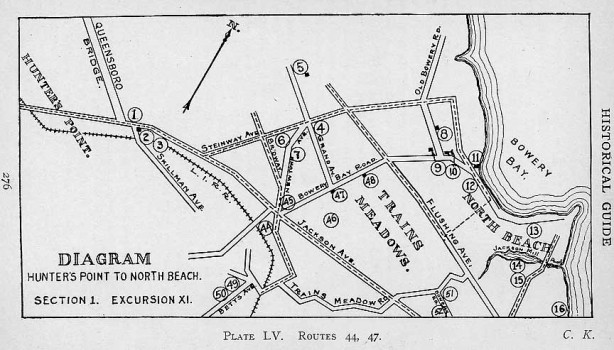
This map, taken from the 1909 Historical Guide to the City of New York, published by Frederick A. Stokes in 1909, shows the Astoria-North Beach-Trains Meadow area in 1909. Just about nothing remains, in its present name, in the near century that has passed. Trains Meadow and the road that passed through it had vanished under the massive Jackson Heights development in the 1920s, now a historic district of its own. Most of North Beach has disappeared in favor of LaGuardia Airport, which opened in 1937, though a very small parcel between the airport and Grand Central Parkway where the Lent Riker Smith House stands is still there. A variety of roads and buildings, now re-named or vanished, are listed in the book. We’ll leave out Numbers 1-7, since they’re in Astoria and not on this page’s purview. (The map skips from #16 to #44 because another map overlaps the section.) Note that the just-opened Queensboro Bridge is on the map, but Queens Boulevard is not: it began construction in 1910.
 … is one of Queens’ oldest highways; it originally ran from Newtown Creek northeast across Long Island to Bowery Bay, a bay in the East River. In the early 20th Century the overlapping street grid and construction of housing caused the road to become disused and it was demapped, but some present roads and fragments, such as Laurel Hill Blvd., Celtic Avenue, Hobart Street, 49th and 51st Streets, Hazen Street, and 19th Road — where the Lent Riker Smith Home stands — were portions of Bowery Bay Road.
… is one of Queens’ oldest highways; it originally ran from Newtown Creek northeast across Long Island to Bowery Bay, a bay in the East River. In the early 20th Century the overlapping street grid and construction of housing caused the road to become disused and it was demapped, but some present roads and fragments, such as Laurel Hill Blvd., Celtic Avenue, Hobart Street, 49th and 51st Streets, Hazen Street, and 19th Road — where the Lent Riker Smith Home stands — were portions of Bowery Bay Road.
Captain Samuel Moore was the great-great-grandfather of Clement Clarke Moore, of “A Visit From St. Nicholas” fame. C.C. Moore spent much of his childhood in Newtown and a playground at 56th Avenue and 92nd Street, near Queens Center, was renamed Clement Clarke Moore Homestead Park in 1998. The Samuel Moore house vanished early in the 20th Century and other than that, not much of the Moore family in Queens remains except for the Moore-Jackson Cemetery on 54th Street near Northern Boulevard.
Old Bowery Road is not to be confused with Bowery Bay Road. Cut back to between 31st and 46th Streets north of 20th Avenue, it is now called 20th Road.
9-10. Designated “a group of 17th Century houses” including the Bowery Bay schoolhouse “near the bend of the road.” Old maps show Bowery Bay making a sudden zigzag between 20th and 21st Avenues which would have taken it across the path of today’s Hazen Street. These are long gone.
11. The Lent Riker Smith House, designated the “Rapalye House” in the Historical Guide.
12. Riker Homestead, another house owned by the Rycken/Riker family, constructed in the 17th Century. Unlike its neighbor it has not survived the years since 1909, burning down in the late 1930s.
13, 14, 15. Farmhouses belonging to the Rapalye and Kouwenhoven families. These of course have not survived, but strangely, the road to them has–it became home to a trolley spur to North Beach, parts of which are still there!
44. “Narrow Passage”, a strip of dry land between swamps during the Revolutionary period. Hurlgate Ferry Road, now Woodside Avenue, crossed through here and the narrow dry slot is the reason for its twisting route.
45. Jackson Mansion, now Woodside houses, Northern Boulevard and Newtown Road.
46. Moore-Jackson Cemetery, the accompanying burial ground to the vanished Moore mansion on 32nd Avenue near 52nd Street. The cemetery is still there on 54th Street.
47. Rapelye-Purdy House, Bowery Bay Road and Grand (30th) Avenue. It was the site of a Revolutionary War skirmish in which one of Cornelius Rapelye’s slaves, Fronce, shot and killed a Scottish Highlander of the Black Watch. Woodside: A Historical Perspective
The Rapelye-Purdy House survived until the early 1930s when it was razed so the massive Boulevard Gardens municipal housing complex could rise in the place of the homesteads and truck farms that occupied the site until then.
48. This was yet another Riker farmhouse built by the son of Abraham Lent, who built it on Bowery Bay Road south of the present Astoria Boulevard in 1717. “According to theHistorical Guide, “in 1776 the house was plundered by the British, and later Hessian troops encamped nearby used the great oven to bake their bread.” Though it still stood in 1909, it’s long gone now.
And so, though plenty of 17th Century dwellings were still there in 1909, the only building left from colonial times is the Lent Riker Smith House.
Michael and Marion
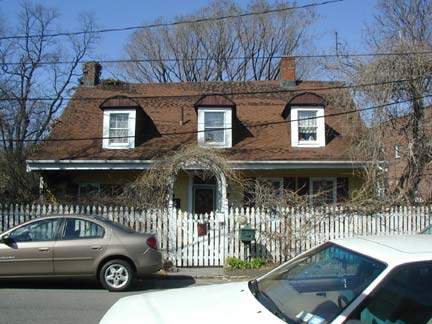
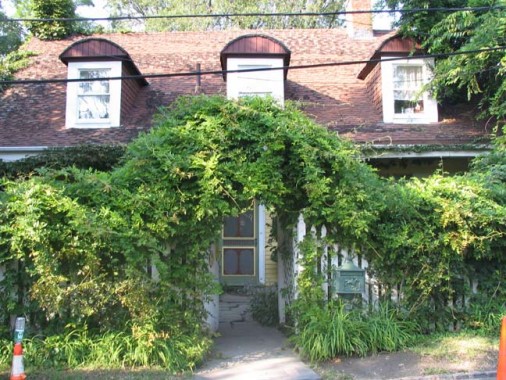
The Lent Riker Smith House in winter and summer.
Let Marion Smith relate the story of how she and her husband Michael rehabilitated the run-down Lent Riker House beginning in the mid-1970s and made it into one of Queens’ premier showpieces. Her story appeared in the Old-House Journal in June 1986, when they were only partially finished.
“The first time I saw the house it was a cold. Desolate night in November, 1979. I had known Michael for a month. We were on our second date.
“Where are we going?” I inquired. “How would you like to see my cemetery?” he said.
His house stood abandoned in Jackson Heights, Queens. It had been unoccupied for almost four years. It was known as the “haunted house” of the neighborhood and it had repeatedly been burglarized and robbed.
“And he really did have his own cemetery, behind the house. It was the burial ground for the once prominent Riker family, among the first Dutch settlers in this area…I stood shivering in the middle of the neglected cemetery, surrounded by broken, toppled and shattered headstones, shaking my head, not believing a place like this could still exist in New York City. The house itself was dark, cold, cluttered, and sagging; it seemed shrouded in mystery and ready to cry…”

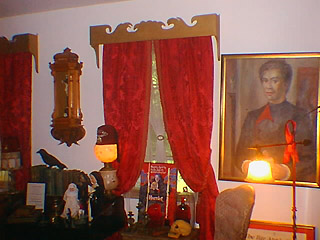
The library of the Lent Riker Smith house features two portraits of Mrs. Smith (above) and her late brother Charles (below) on the walls. correctionhistory.org
The Lent Riker cemetery plot contains 131 interments, the oldest of which goes back to 1744, the latest Marion’s brother Charles. Many prominent Queens families who married into the Riker family, the Lawrences, the Brinkerhoffs, are here as well.
(LEFT): “In Memory of DEBORAH, wife of Daniel Riker and daughter of William & Dorothy Leverich, who died April 9th, 1818; aged 45 years, 10 months & 5 days. ‘Weep not my friends all dear, I am not dead but sleeping here; The debt is paid, the grave you see, Prepare for death and follow me.”’


Family room and kitchen. The kitchen is believed to date from Abraham Lent’s 1729 expansion of the original small farmhouse. correctionhistory.org
The Smiths first set to work cleaning and repairing the house’s attic, which had not been touched for over a century at the time. The estate’s accountant had stored all family papers there dating back to 1883…ledgers, wills, diaries, photographs, all of which passed to Michael Smith when he purchased the building. Mrs. Smith found a treasur6e trove of historical ephemera, bottles, pot belly stoves, wood venetian blinds, wooden cabinets, and 54 hardbound financial directories. Most have been incorporated into the house’s decor while the papers were donated to a museum, resulting in a handsome tax deduction.
“We were lucky enough to find a retired neighbor, Mr. Osso, [who did the] sanding, painting, fixing and stripping. I didn’t mind hard work either, so he and I developed a great working arrangement. He did most of the stripping while I pushed, pulled, dug, scribbed, crawled and said goodbye to my fingernails. I may have found my prince but I still felt like Cinderella, always down on my knees working while everyone else got to go to the ball.” Under the gold shag 1960s carpeting and linoleum, Mrs. Smith and Osso found the building’s 300-year-old wood plank floors. “The kitchen had a Formica countertop and linoleum on the floor…poor house, so humiliated, so misunderstood….it took a couple of months to find a scrubbed-pine sideboard just the right size to convert. We took off its wood top, selected tiles for the surface, bought a stainless steel sink. Voila, our piece de resistance.”


The front door bears a plaque on each side; the one on the left is from the New York Community Trust and was placed in 1960 while on the right is a newer Queensmark designation awarded by the Queens Historical Society.
One of the cows from the 2000 Cow Parade in NYC seems to have wound up in the yard.
While renovating the dining room, Mrs. Smith opined: “How I wished I could go back in time to this very spot 300 years ago, and see the room as it was then! I knew that whoever was here then must have felt the same as we did now – full of the excitement and expectation of finishing a room, creating a home. Pete and Bill [two helpers] told me that the beams in the dining room originally come from a barn. This too filled me with images of those long-ago Rikers, razing a barn somewhere to begin the venture of building this homestead. Another missing piece to a puzzle, another bit of history retrieved…
“I decided to take a breather from the indoor work and start on the outside. Visions of a secret garden, gazebo and circular porch danced through my head. ‘Paradise Acre,’ that’s what I’ll call it.”
The Smiths have realized this vision of a showplace backyard, even erecting a Victorian-style “gingerbread cottage.” Their Secret Garden encircles the cemetery.

The Lent Riker Smith House’s ivied west wall faces the gazebo and Secret Garden.

Marion Smith greets tour guests in the Lent Riker Smith House’s hallway.correctionhistory.org
Sadly, Michael Smith passed away in November 2010.
SOURCES:
![]() The definitive history of the Lent Riker Smith House, and of Dutch colonial families in the area, can be found at the Rikers Island Corrections’ history pages, which reprint Edgar Alan Nutt’s The Rikers: Their Island, Homes, Cemetery and Early Genealogy in Queens County, NY. Nutt is a direct descendant of patriarch Abraham Rycken van Lent.
The definitive history of the Lent Riker Smith House, and of Dutch colonial families in the area, can be found at the Rikers Island Corrections’ history pages, which reprint Edgar Alan Nutt’s The Rikers: Their Island, Homes, Cemetery and Early Genealogy in Queens County, NY. Nutt is a direct descendant of patriarch Abraham Rycken van Lent.
![]() The Smiths’ Lent Riker Smith House page
The Smiths’ Lent Riker Smith House page
![]() Historical Guide to the City of New York, Frank Bergen Kelley, Frederick A. Stokes 1909
Historical Guide to the City of New York, Frank Bergen Kelley, Frederick A. Stokes 1909
![]() Woodside: A Historical Perspective 1652-1994, Catherine Gregory, Woodside on the Move 1994
Woodside: A Historical Perspective 1652-1994, Catherine Gregory, Woodside on the Move 1994
ALSO:
The Romantic Garden, Marion Duckworth Smith, Sterling/Chapelle 2004
BUY this book at Amazon.COM
Thanks to Jen Itzenson and Marion Duckworth Smith for their assistance with this page
This page was photographed September 17, 2006 and completed September 24

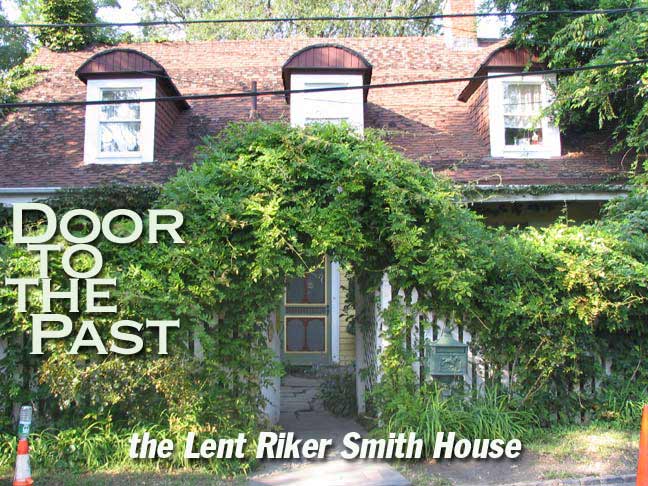


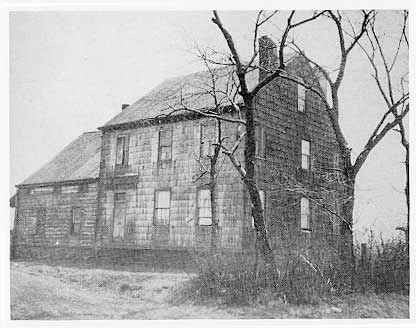

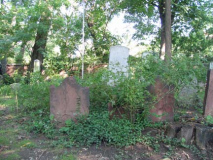
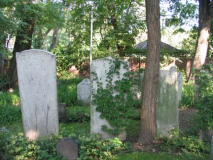

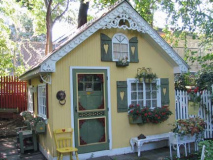
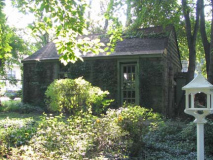
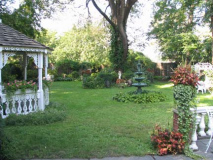
17 comments
Please let me know if tours of this lovely olde house are still happening and if so, when. I would really appreciate being allowed to visit.
With thanks, Diana Shikiar
Burdett Brinckerhoff Lent told me the story of visiting the Lent home many years ago. Many thanks for loving this home back to life.
Rosemarie Lent
Ladera Ranch, CA 92694
I saw this charming home recently. Marion Duckworth Smith is a lovely lady. She works tirelessly at preserving this wonderful historical homestead and cemetery.
When I met Marion, I felt like I met a long lost friend or family member. I hung on her every word and really enjoyed hearing about her and her husband’s journey.
Best wishes, Kerrie Hansen (Glendale, NY)
As a direct descendant of Abram Rycken van Lent I am extremely grateful to the Smiths and all that they have done to preserve and love this unique and irreplaceable house and property.
A few years ago after a life time of genealogical research I finally found the evidence to tie my line back to Abram’s family in Njmegen, Netherlands. I was accepted as a member of the Holland
Society of New York. I had family tales since my earliest but no evidence. I went to Stuyvesant
High School in the late 1930s and early 1940s. I did my first unsuccessful research at the 42nd
Street library as it was on my route to school. I have been to Njmegen both during the war and
while studying in Europe . My concern now is the future of the Lent-Riker Smith House and the
preservation of the legacy of Michael and Marion. As an Architect and Holland Society Member
I would be very pleased to join in any effort to support this goal. Roy van Lent AIA
Good Morning, I have been researching my families ancestry for the past six months.
I am a direct decent of Christian Scheurer (1819 DOB) and Eve Emeline Nicholas Scheurer, (May 25, 1825) they had six children, one being listed as Mrs. Riker of Astoria (DOB cira 1862).
The Scheurers were a prominent family in the 1870’s. Eva E. Scheurer was the first women Superintendent of the Saint Michael’s Cemetery (1857), her son Edward E. Scheurer (DOB 1856) succeeded her in that post in Oct 26, 1879. Edward E. Scheruer owned and operated the Elite Hotel on Baldwin and Flushing Ave, which is now Astoria Blvd. and 48th. Street.
Eva’s second son, William H. Scheurer, (DOB 1860) -(my Great Grandfather) owned and operated the Queens County Hotel, located on Bowery Bay Road and Flushing Ave, which is now Astoria Blvd. and 48th. Street. William H. and Edward. E. also owned the Scheurer Monumental Yards which was between and behind their two Hotels. Edward and William were very prominent in all of the Astoria Life, Lodges , Churches and Democratic Clubs throughout their lives.
I would like to known if their sister Mrs. Riker was part of the Lent Riker Smith Family. Thank you
My mom has a picture of my great-aunt, a Riker, standing at the gates to the cemetery. It is black and white and I think was taken in the 1950s. My great-grandfather’s name was William Riker. So amazing to see the wonderful work Mrs. Smith has done on the house.
As a direct descendent of Abram Rycken Van Lent (my 7th grandfather), I am truly fascinated studying the history of his house. I am greatly indebted to the Smiths for their kind and professional care. I will be coming to New York on Sept.7-14 for my 50th high school reunion in New Jersey on September 9, 2017. I see there is a tour that day, but there is no way I can make it with the reunion scheduled Saturday evening in the NJ shore area. Is there a way I could see the home during the week? I will bring my pedigree as a Lent, ( Jacob Lent 1754-1843) is my Revolutionary War Patriot for my Daughters of the American Revolution membership. Please let me know if this is possible? Also, I am coming from Texas so I will need some directions to find the home.
You wound need to contact Marion Smith
What fun to be able to see photos of the Lent-Riker-Smith Homestead. I see I’m in good company with other direct descendants of Abraham Rycken Van Lent. He was my 12x grandfather and was my patiot when I became a member of Colonial Dames 17th century.Can anyone tell me if this house is protected from developers? With so many of my family members buried in the back yard, I am hopeful that it could never be demolished. I hope to visit one day.
I would love to visit the house and meet Mrs. Smith. Are tours still available? I tried to join the Riker-Ryker Historical Society and my letter was returned. My mother is a Riker and we are direct descendants. I am researching the name and am trying to search as far back as possible. Thanks.
Yes she still has tours
As a direct descendant, I couldn’t wait to take the tour with my husband. While I found it very interesting, I was also very disappointed. I expected to hear a lot about the Lent/Riker history, which a lot of I already knew. Unfortunately most of what we heard was HER history and HER family and HER acting career, etc. Not enough about why people would really go there. These were my ancestors, so I just assumed … I don’t deny that she’s taken good care of the house, except for the TONS of cats she has let run around and destroy the original floors in the center of the house. But HER history and her dad’s and brother’s military career and daughter’s dancing career, has absolutely nothing to do with this homestead. And I also have to say that I feel totally disrespected that she would have her father buried in a cemetery supposedly for “relatives and relations” according to the original cemetery deed, of Lents and Rikers!! The cemetery also is not part of the “owned” property of the house, also according to the cemetery deed, and should be “ingressed and egresseed by anyone wanted to go into the cemetery”. I understand she wants to sell books and that she dreamed of being an actress, etc., but really find another soapbox – it shouldn’t be a historical home for Lents and Rikers.
how about i say this ok my name is william and my mother name was irene riker and was told by my father and family that a ancestor from ym others side of the family who co founded the island named Abraham Rycken,[2] a Dutch settler who moved to Long Island in 1638 and whose descendants owned Rikers Island until 1884, when it was sold to the city for $180,000. Now i feel as if in the history books no one is talking about the history of the island, The island was used as a military training ground during the Civil War. The first regiment to use the Island was the 9th New York Infantry, also known as Hawkins’ Zouaves, which arrived there on May 15, 1861. Hawkins’ Zouaves was followed by the 36th New York State Volunteers on June 23, which was followed by the Anderson Zouaves on July 15, 1861. The Anderson Zouaves were commanded by John Lafayette Riker who was related to the owners of the island. The camp of the Anderson Zouaves was named Camp Astor in compliment to millionaire John Jacob Astor Jr. who provided funding for the army, and who appears to have made a significant contribution to the raising of the Anderson Zouaves in particular, with the Astor ladies being credited with the manufacture of the zouave uniforms worn by the recruits of this regiment. Rikers Island was subsequently used by numerous other Civil War regiments, but the name “Camp Astor” was specific to the Anderson Zouaves and did not become a general name for the military encampment on the island.
Aerial photo of Rikers Island, photographed from the North. LaGuardia Airport and its 4/22 runway stretch is visible, 250 feet (76 meters) from the island. Shea Stadium can be seen across Flushing Bay.
In 1883 New York City’s Commission of Charities and Corrections expressed an interest in purchasing the island for use as a work-house. Any such purchase would have to be approved by the state. In January 1884 state senator Frederick S. Gibbs introduced a bill in the state senate authorizing the commission to purchase the island.[25] In May 1884 Governor Grover Cleveland signed a bill authorizing the Commissioner of Charities and Corrections to purchase the island for a sum no greater than $180,000.[26] At the time, the island was within the boundaries of Long Island City, which was located in Queens County, which was not yet part of New York City, and this potential transfer set off squabbling between politicians of Long Island City, Queens County, and New York City.[27] On July 31, 1884, a compromise was agreed to by all three entities, New York City agreed to pay a total of $3,000, to be disbursed as $2,500 to Long Island City and $500 to Queens County.[28] On August 4, 1884, the Commissioner of Charities and Corrections, Jacob Hess, signed a contract purchasing the island from John T. Wilson, a descendant of the Ryker family, for $180,000: $179,000 to Wilson and $1,000 for a title search.
Hi it is not so much a comment as a question? My husband was in that house in the seventies. He was a sanitation worker who pick up the garbage at that house. He met the couple that.lived at that and he and his co-worker were given a tour. He said the house was in bad condition and they could only see the front rooms. They could not go upstairs and was informed that the basement was off-limits as well because of the :chains and rings”attached to the walls.and the said was kind of creepy. He found that.hard to believe but could get no further history on that comment. We were long time residents of Astoria until we moved to Long Island and have always been fascinated by old homesteads and there history. Is there any truth to this residents comments about the cellar and its chains love to hear about it
Respectfully yours Mary Ann Milletich.
Michael Smith purchased it and restored it. His widow lives there now and has maintained it spectacularly.
I grow up in Astoria and never knew about this house till several months ago. I have recently moved to the Garden Bay condos and walk around the neighborhood and found the house. So sad to see the overgrown foliage and uncared for garage and house. i don’t know what the inside looks like, so that may be fine. Today I found the cemetery!! Its
completely surrounded by other structures and homes, but I could see the tombstones. I saw the cow from2000!!
Marion Smith has cared for the house since Michael Smith’s death, but I haven’t been over there lately. She is getting on. You’re saying the house looks bad now?